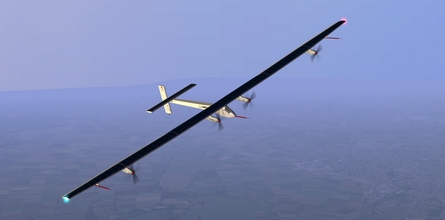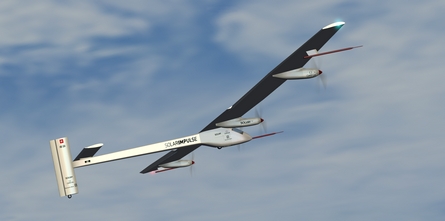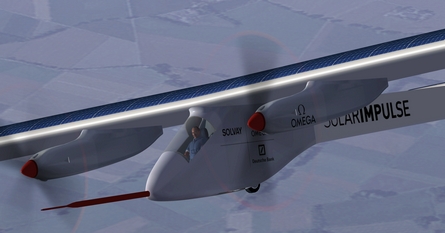The Swiss-based Solar Impulse team planning a round-the-world solar-powered flight in 2011 has unveiled the design of a prototype aircraft being built to demonstrate a complete day-night-day cycle in 2009.
Construction of the 61m-span prototype, registered HB-SIA for "Solar Impulse Alpha", began in June at the team's Lausanne, Switzerland facility, where flight tests are expected to begin in the fourth quarter of 2008.
With 200m² of solar cells on the wing and horizontal tail, 400kg of lithium-based batteries and four electric motors driving propellers, HB-SIA is intended to make a 36h flight to demonstrate the ability to operate through a complete day-night-day cycle without fuel.


HB-SIA - "Solar Impulse Alpha" © Solar Impulse
The single-pilot aircraft will take off with its batteries fully charged, climb to 8,500m (28,000ft) during the day under solar power and descend to 1,000m during night under battery power. The goal is to have enough power remaining to begin the cycle again the next day, says Solar Impulse chief executive André Borschberg.
HB-SIA will be powered by four electric motors each producing a maximum of 10hp (7.5kW), but averging only 2.5hp, he says. This will be sufficient for a flying speed of around 45km/h (25kt).
With the solar cells able to generate only 30W/m² in electrical power, the prototype's weight is limited to 1,500kg. There will be no heating for the single pilot. Instead the cockpit will be constructed from a lightweight insulating material, he says.

© Solar Impulse
Borschberg says the biggest challenge is flight control of an aircraft as large, light and slow as the Solar Impulse, particularly in turbulent air, and the prototype will be used to validate simulations developed by team partner Dassault Aviation.
The prototype "will be a first approach to optimising the balance between energy consumption, weight, performance and controllability", says Solar Impulse.
Flight testing will begin without the solar cells installed and will be limited to flights along the Lausanne runway at heights ranging to 2m to 20m, he says. Flight testing will then relocate to Bienne, also in Switzerland. The location for the 36h flights has yet to be decided, but president Bertrand Piccard says Solar Impulse "has good contacts to make some of the flights in oil-producing countries" interested in the potential of solar power.
Solar Impluse says a second aircraft will be developed to attempt to fly several 24h cycles consecutively, leading up to the first transatlantic flight in 2011 and then the first round-the-world flight. The circumnavigation would involve a series of five-day flights, flown alternately by Borschberg and Piccard.
Major sponsors for the project are Swiss watch manufacturer Omega and chemical and pharmaceutical group Solvay, as well as Deutsche Bank. Piccard says the existing backing is sufficient to complete the prototype flights, but a fourth major sponsor will be required for the round-the-world flight.
Although Solar Impulse was originally planned as a Swiss project, Piccard says the team is now looking outside Switzerland for the fourth sponsor. "If would be good to have partners from around the world," he says.

© Solar Impulse
Source: FlightGlobal.com
















